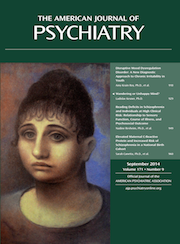Response to Mattes
To the Editor: The report of highly significant differences between persons with schizophrenia and comparison subjects in the right hippocampus should not be misinterpreted to suggest that effects are strongly lateralized. Total hippocampal intrinsic resting activity was reanalyzed by averaging activity across both the left and right hippocampi. Schizophrenia patients showed greater response than control subjects (t=2.6, p=0.013), indicating that total intrinsic hippocampal activity is indeed elevated in patients.
In our previous work, the most significant group differences have been reported in either the left or right hemisphere but were often present bilaterally at more liberal statistical thresholds. For example, in our 2012 study of the effects of distracting noise on hippocampal response and attention networks (1), we reported higher left hippocampal activity in patients in response to distracting noise at a significance threshold of p<0.01, but greater activity also was observed in the right hippocampus at a threshold of p<0.02 (t=2.5). Similarly, in our 2011 study to determine whether the alpha 7-nicotinic partial agonist 3-(2,4-dimethoxybenzylidene)-anabaseine (DMXB-A) can lower hippocampal hyperactivity in schizophrenia patients (2), the threshold for the primary result, reduction of right hippocampal activity, was reported at p<0.01. However, at a threshold of p<0.04 (t=2.0), the drug also was associated with reduced activity of the left hippocampus. These observations are consistent with the larger imaging literature, which suggests that both structural and functional hippocampal differences in schizophrenia are consistently observed in both the right and left structures (3).
1 : The effect of distracting noise on the neuronal mechanisms of attention in schizophrenia. Schizophr Res 2012; 142:230–236Crossref, Medline, Google Scholar
2 : Functional magnetic resonance imaging of effects of a nicotinic agonist in schizophrenia. Neuropsychopharmacology 2010; 35:938–942Crossref, Medline, Google Scholar
3 : Hippocampal function, declarative memory, and schizophrenia: anatomic and functional neuroimaging considerations. Curr Neurol Neurosci Rep 2005; 5:249–256Crossref, Medline, Google Scholar



